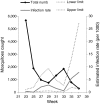Francisella tularensis subspecies holarctica occurs in Swedish mosquitoes, persists through the developmental stages of laboratory-infected mosquitoes and is transmissible during blood feeding
- PMID: 24057273
- PMCID: PMC3907667
- DOI: 10.1007/s00248-013-0285-1
Francisella tularensis subspecies holarctica occurs in Swedish mosquitoes, persists through the developmental stages of laboratory-infected mosquitoes and is transmissible during blood feeding
Abstract
In Sweden, mosquitoes are considered the major vectors of the bacterium Francisella tularensis subsp. holarctica, which causes tularaemia. The aim of this study was to investigate whether mosquitoes acquire the bacterium as aquatic larvae and transmit the disease as adults. Mosquitoes sampled in a Swedish area where tularaemia is endemic (Örebro) were positive for the presence of F. tularensis deoxyribonucleic acid throughout the summer. Presence of the clinically relevant F. tularensis subsp. holarctica was confirmed in 11 out of the 14 mosquito species sampled. Experiments performed using laboratory-reared Aedes aegypti confirmed that F. tularensis subsp. holarctica was transstadially maintained from orally infected larvae to adult mosquitoes and that 25% of the adults exposed as larvae were positive for the presence of F. tularensis-specific sequences for at least 2 weeks. In addition, we found that F. tularensis subsp. holarctica was transmitted to 58% of the adult mosquitoes feeding on diseased mice. In a small-scale in vivo transmission experiment with F. tularensis subsp. holarctica-positive adult mosquitoes and susceptible mice, none of the animals developed tularaemia. However, we confirmed that there was transmission of the bacterium to blood vials by mosquitoes that had been exposed to the bacterium in the larval stage. Taken together, these results provide evidence that mosquitoes play a role in disease transmission in part of Sweden where tularaemia recurs.
Figures




References
-
- Huber B, Escudero R, Busse H, Seibold E, Scholz H, Anda P, Kämpfer P, Splettstoesser W (2009) Description of Francisella hispaniensis sp. nov., isolated from human blood, reclassification of Francisella novicida (Larson et al. 1955) Olsufiev et al. 1959 as Francisella tularensis subsp. novicida comb. nov., and emended description of the genus Francisella. Int J Syst Evol Microbiol 60:1887–1896 - PubMed
-
- Sjöstedt AB, Brenner DJ, Krieg NR, Staley JT, Garrity GM (2005) Family XVII. Francisellaceae, genus I. Francisella. In: Anonymous (ed.) Bergey's manual of systematic bacteriology. Springer, New York, pp. 200–210
-
- Johansson A, Celli J, Conlan W, Elkins KL, Forsman M, Keim PS, Larsson P, Manoil C, Nano FE, Petersen JM, Sjöstedt A. Objections to the transfer of Francisella novicida to the subspecies rank of Francisella tularensis. Int J Syst Evol Microbiol. 2010;60:1717–1718. doi: 10.1099/ijs.0.022830-0. - DOI - PMC - PubMed
-
- Busse HJ, Huber B, Anda P, Escudero R, Scholz HC, Seibold E, Splettstoesser WD, Kämpfer P. Objections to the transfer of Francisella novicida to the subspecies rank of Francisella tularensis—response to Johansson et al. Int J Syst Evol Microbiol. 2010;60:1718–1720. doi: 10.1099/00207713-60-8-1718. - DOI - PubMed
Publication types
MeSH terms
Substances
LinkOut - more resources
Full Text Sources
Other Literature Sources
Medical

